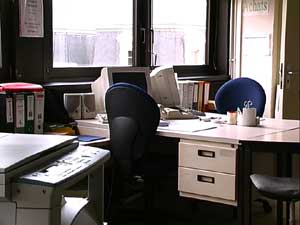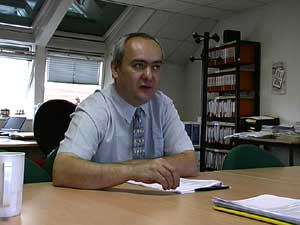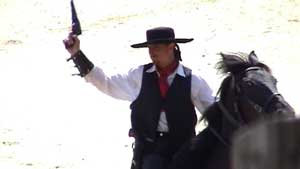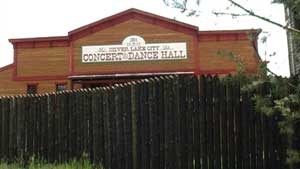Marie Voignier zeigt die Videoarbeiten
Ghosts (Les Fantomes ) : France 2004
und
W estern DDR : France-Allemagne 2005
Die Arbeiten mit dokumentarischen Anteilen befassen sich zugleich mit
der Art und Weise der Entstehung einer Erzählung.
Text bisher nur auf englisch




Working
Ghosts
Marie
Voignier
13. bis 22. Januar 2006
Eröffnung am Freitag, den 13. Januar 2006, 19 Uhr
im Rahmen des warm up auf dem 19. Stuttgarter Filmwinter in Kooperation
mit Wand5.
Off-Side
Portraits. A still shot of a man in a shirt and tie who is explaining in detail a concept of a virtual company (with inserts of empty offices). A young woman is reading through and trying to mime the synopsis of a stand-up routine in a back-yard (cut-editing on her failed attempts). Aspiring actresses talk freely about their motivation and their frustrations (synthesis of their remarks in voice-off). A woman poses like a starlet in front of an open-air cinema screen (photographs). Mostapha, a mediator at Vénissieux, reads a commentary of summer of 2003 (soundtrack over watercolours and drawings). Readers give public recitals of transcriptions of internet chat (with smiley signs) or a courtroom report…
Made using minimal performance, Marie Voignier’s work does not provide much to see. Simple frames. Few effects. Concentration and precision. Reconstructions which seem rudimentary at first glance, which do not try to give the “impression of reality” and seem even more formally reduced as they contain complex risks in terms of performance. For it is not so much a question of veracity which is at stake here, rather the – far more indistinct - fictional off-camera activity. That is to say: to only show characters which are acting, but acting alone. Without an audience. Without a stage. Off-side (as in football). Measuring the remains of illusion and interpretation behind the scenes of reality, in spontaneous and intimate gestures and expression. Like a smuggler, Marie Voignier paces up and down the indistinct boundaries which separate real identity and fictional role, by summoning the invisible theatre of inner fantasies. And if these short sketches convey an indefinable emotion, it is that which comes from the vigour (in this case, verbal) of the human being grappling with his own scenario: intimate, social or professional. Consequently the seemingly neutral places chosen by the artist as the setting for these accounts define so many theatrical spaces at the heart of daily life. The empty office, the cemetery, the living room, the multimedia library… A scenographic condensation which respects the rules of tragedy: unity of time, place and action.
Refereeing
As the director, the artist is not the objective guardian of these accounts. She composes “assisted” portraits of some of her contemporaries. Her formal, discreet interventions are no less essential: to carry out a distancing, a breaking off from the subject each time. Rewriting, voices-off, reinterpretations, off-camera, graphic inserts, cut-editing: So many methods in order to establish an artificial but intentional dialogue with her characters. So many transcendent and quasi-telepathic strategies. Deciphering. Translations. It is not surprising that the artist often demonstrates an interest in judicial rituals: a trial offers a dramatisation of reality behind closed doors, not broadcast, which is only based on the “official report”. In the end: talking in place of. Moreover, the watercolours from the video Untitled (Vénissieux Multimedia library) (1) and the drawings from the installation Beirut Locations refer directly to the paradoxical status of courtroom sketches. The same efficiency in removing the realism. The same concern for objectivity which fictionalises. The same distant immediacy. With Marie Voignier, the transcription of mental processes, a desire for narrative objectivity and an interest in using the décor to fictionalise call to mind certain aspects of Duras’ style. Shaping the writing (or the image) as if it were a theatrical expression. Always using indirect speech. Stuttering. In voice-off, the artist rehearses the speech given by Maryline, the « goth » which is itself the discourse of a rock group which itself comes from a totalitarian discourse. Who are the authors of these words? A collective work of ghosts.
Penalty area
In spite of a certain gentleness in the attention given to these characters, Marie Voignier’s work gives a subtle criticism of the transitory statute of fiction within social and political fields. A penetrating fiction, which, beyond its objects of collective inscription (novel, story, film) finds itself sent to the heart of the intimate, in an irrepressible movement of individuation. Without nostalgia, but with formidable acuteness, the artist flushes out the erring ways of a collective imagination reduced to efficiency (the fake company, the location search), to fantasy (the actresses, the performer), to chance encounters (the chat). A sort of fictional minimalism, which no longer needs to be invented, but simply framed right at the heart of reality. But there is nothing really desperate here: hope resides in the energy of the transmission, in spite of everything, in the image of this actress who is hesitant yet willing, trying to regain the gestures and signs of a story which has well and truly escaped us.
Guillaume Désanges
(1) This work was carried out with Claire-Lise Panchaud and Florentine Lamarche. Florentine Lamarche was the artist who did the water colours.
Guillaume Désanges is an art critic, exhibition organiser, member of the editorial committee of the magazine « Trouble ». He coordinates artistic projects for the Aubervilliers Laboratories.
Portraits. A still shot of a man in a shirt and tie who is explaining in detail a concept of a virtual company (with inserts of empty offices). A young woman is reading through and trying to mime the synopsis of a stand-up routine in a back-yard (cut-editing on her failed attempts). Aspiring actresses talk freely about their motivation and their frustrations (synthesis of their remarks in voice-off). A woman poses like a starlet in front of an open-air cinema screen (photographs). Mostapha, a mediator at Vénissieux, reads a commentary of summer of 2003 (soundtrack over watercolours and drawings). Readers give public recitals of transcriptions of internet chat (with smiley signs) or a courtroom report…
Made using minimal performance, Marie Voignier’s work does not provide much to see. Simple frames. Few effects. Concentration and precision. Reconstructions which seem rudimentary at first glance, which do not try to give the “impression of reality” and seem even more formally reduced as they contain complex risks in terms of performance. For it is not so much a question of veracity which is at stake here, rather the – far more indistinct - fictional off-camera activity. That is to say: to only show characters which are acting, but acting alone. Without an audience. Without a stage. Off-side (as in football). Measuring the remains of illusion and interpretation behind the scenes of reality, in spontaneous and intimate gestures and expression. Like a smuggler, Marie Voignier paces up and down the indistinct boundaries which separate real identity and fictional role, by summoning the invisible theatre of inner fantasies. And if these short sketches convey an indefinable emotion, it is that which comes from the vigour (in this case, verbal) of the human being grappling with his own scenario: intimate, social or professional. Consequently the seemingly neutral places chosen by the artist as the setting for these accounts define so many theatrical spaces at the heart of daily life. The empty office, the cemetery, the living room, the multimedia library… A scenographic condensation which respects the rules of tragedy: unity of time, place and action.
Refereeing
As the director, the artist is not the objective guardian of these accounts. She composes “assisted” portraits of some of her contemporaries. Her formal, discreet interventions are no less essential: to carry out a distancing, a breaking off from the subject each time. Rewriting, voices-off, reinterpretations, off-camera, graphic inserts, cut-editing: So many methods in order to establish an artificial but intentional dialogue with her characters. So many transcendent and quasi-telepathic strategies. Deciphering. Translations. It is not surprising that the artist often demonstrates an interest in judicial rituals: a trial offers a dramatisation of reality behind closed doors, not broadcast, which is only based on the “official report”. In the end: talking in place of. Moreover, the watercolours from the video Untitled (Vénissieux Multimedia library) (1) and the drawings from the installation Beirut Locations refer directly to the paradoxical status of courtroom sketches. The same efficiency in removing the realism. The same concern for objectivity which fictionalises. The same distant immediacy. With Marie Voignier, the transcription of mental processes, a desire for narrative objectivity and an interest in using the décor to fictionalise call to mind certain aspects of Duras’ style. Shaping the writing (or the image) as if it were a theatrical expression. Always using indirect speech. Stuttering. In voice-off, the artist rehearses the speech given by Maryline, the « goth » which is itself the discourse of a rock group which itself comes from a totalitarian discourse. Who are the authors of these words? A collective work of ghosts.
Penalty area
In spite of a certain gentleness in the attention given to these characters, Marie Voignier’s work gives a subtle criticism of the transitory statute of fiction within social and political fields. A penetrating fiction, which, beyond its objects of collective inscription (novel, story, film) finds itself sent to the heart of the intimate, in an irrepressible movement of individuation. Without nostalgia, but with formidable acuteness, the artist flushes out the erring ways of a collective imagination reduced to efficiency (the fake company, the location search), to fantasy (the actresses, the performer), to chance encounters (the chat). A sort of fictional minimalism, which no longer needs to be invented, but simply framed right at the heart of reality. But there is nothing really desperate here: hope resides in the energy of the transmission, in spite of everything, in the image of this actress who is hesitant yet willing, trying to regain the gestures and signs of a story which has well and truly escaped us.
Guillaume Désanges
(1) This work was carried out with Claire-Lise Panchaud and Florentine Lamarche. Florentine Lamarche was the artist who did the water colours.
Guillaume Désanges is an art critic, exhibition organiser, member of the editorial committee of the magazine « Trouble ». He coordinates artistic projects for the Aubervilliers Laboratories.